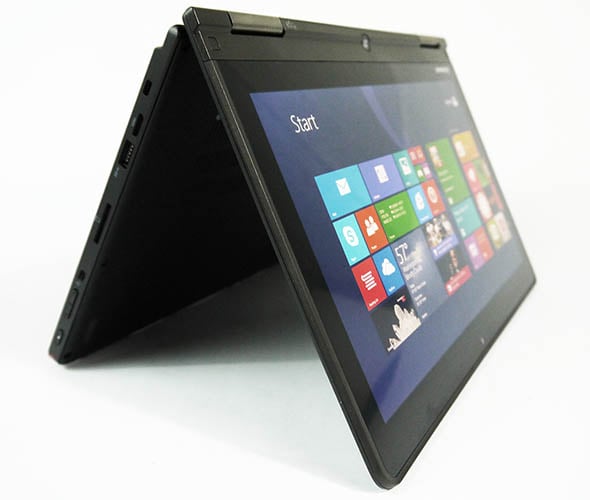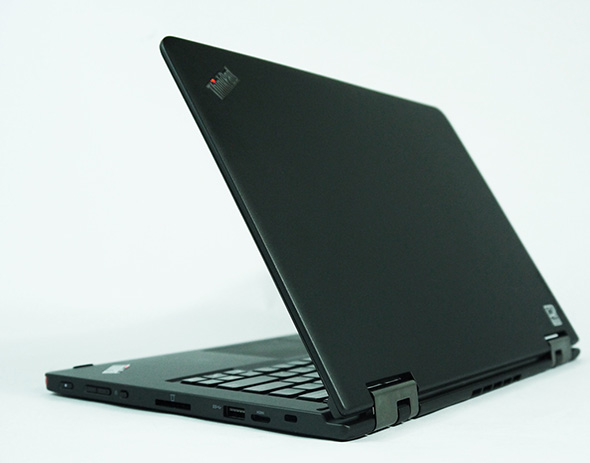Lenovo Thinkpad Yoga: A Yoga Dressed For Business
Design
As we mentioned earlier, the Lenovo ThinkPad Yoga offers the flexibility of a Yoga with some of the desirable, rugged functionality of a ThinkPad. In the case of the latter, this ultrabook has the same keyboard and touchpad as the Lenovo ThinkPad T440s we recently reviewed--only this one is the slightest bit smaller.

The keyboard area has many of the same layout choices as the previous generation of ThinkPads, but key caps are designed a little better, more shaped to your fingertips. The trackpad is glass and incorporates five clickable buttons, including the middle scroll button that’s been replaced by subtle bumps, and the TrackPoint buttons are now simply indicated by red stripes instead of being separate buttons entirely.
That iconic red trackpoint button is still in the middle of the keyboard, which is spill-proof and backlit, and there are plenty of dedicated keys across the top of the keyboard area, including volume controls, screen brightness, WiFi toggle on/off, settings key, and more. You can also toggle the keyboard backlighting on, bright, and off with the Fn key and the spacebar.
This keyboard has a neat trick that other ThinkPads don’t have, though--the Lift ‘n’ Lock feature. When you use the ThinkPad Yoga in its various modes, sometimes the keyboard is facing down on a surface. That’s both awkward and not ideal for the machine, especially if there’s moisture or a lot of dirt. The Lift ‘n’ Lock keyboard raises up the area around the keyboard so that the whole thing sits flush.
The various modes include the standard laptop configuration, as well as a tent mode that’s ideal for presentations or simply browsing the web or watching a movie; stand mode, which is good for many of the same applications as tent mode in addition to conducting video calls; and a tablet mode, which is self-explanatory.
Regardless of which mode you’re in, the necessary buttons and ports are all distributed along the edges of the device. On the left side you’ll find the headphone/mic jack, one of the USB 3.0 ports, and the DC-in and Lenovo OneLink ports. (The OneLink port is for connecting an optional Lenovo OneLink Dock, a $99 accessory that offers HDMI video, USB 3.0, Ethernet, and notebook charging capabilities.)
The right side of the chassis houses the other USB 3.0 port as well as the mini HDMI port, lock port, 4-in-1 card slot, volume and display lock button, the power button, and the tablet-style volume rocker.

That display lock button is a great little feature. There’s often a bit of awkwardness if you’re using a tablet or other device to show something to someone and the screen orientation flips when you don’t want it to. If you engage the lock button on the ThinkPad Yoga, that won’t happen.
The multimode functionality is of course a desirable feature, and the Lift ‘n’ Lock keyboard (despite its arguably hokey name) is a smart way to cut down on the problems associated with resting the ThinkPad Yoga on its keyboard and touchpad, but even so we couldn’t help but feel as though we might damage the notebook, or at least get the device dirty, when it's used in those orientations. Further, the front and bottom edges don’t have any scratch protection or bumpers, so in tent mode, so you might worry about marring them as well. In short, the utility is great with these design features but treading lightly in use is advised.
That said, as always it seems, the overall build quality feels very solid with this ThinkPad. Lenovo made a point to mention the Thinkpad Yoga’s durability--it was built with a magnesium-alloy frame with zinc alloy hinges that the company says can handle 30,000 open and close cycles, and the display is made from Corning Gorilla Glass.
As part of its business dress, if you will, the ThinkPad Yoga comes sporting a digital stylus that slips into the chassis on the right front corner. With pen input plus a clickable button on the shaft of the stylus, it’s useful for a number of applications from taking notes to making drawings to web browsing to guiding colleagues through a PowerPoint. We found it to be comfortably responsive when jotting down text, although it feel quite small in our fingers. After a while, that grip got wearisome, and the clickable button is in an awkward location; you have to hold the stylus just so or else you won’t be able to easily reach the button without changing your hand position.
The chassis as a whole is rather thin, and appropriately, it falls somewhere between the Yoga 2 Pro and ThinkPad T440s in terms of thickness. The ThinkPad Yoga is 0.74-0.76 inches thick, whereas the Yoga 2 Pro is 0.61 inches and the ThinkPad T440s is 0.8 inches.
In terms of weight, again the ThinkPad Yoga is a tweener at 3.52 lbs, as the Yoga 2 Pro weighs in at a more svelte 3.06 lbs while the heftier ThinkPad T440s is 3.99 lbs.
The ThinkPad Yoga’s speakers deliver average notebook audio. The balance was adequate and reasonably clear, and the volume was acceptable in that the system easily produces enough audio to fill a conference room during a presentation. Of course, there’s no bass response to speak of, and we found that there was some crackling. It wasn’t noticeable in louder rock music, surprisingly but it stuck out in quieter pieces such as a string quartet.

The keyboard area has many of the same layout choices as the previous generation of ThinkPads, but key caps are designed a little better, more shaped to your fingertips. The trackpad is glass and incorporates five clickable buttons, including the middle scroll button that’s been replaced by subtle bumps, and the TrackPoint buttons are now simply indicated by red stripes instead of being separate buttons entirely.
That iconic red trackpoint button is still in the middle of the keyboard, which is spill-proof and backlit, and there are plenty of dedicated keys across the top of the keyboard area, including volume controls, screen brightness, WiFi toggle on/off, settings key, and more. You can also toggle the keyboard backlighting on, bright, and off with the Fn key and the spacebar.
This keyboard has a neat trick that other ThinkPads don’t have, though--the Lift ‘n’ Lock feature. When you use the ThinkPad Yoga in its various modes, sometimes the keyboard is facing down on a surface. That’s both awkward and not ideal for the machine, especially if there’s moisture or a lot of dirt. The Lift ‘n’ Lock keyboard raises up the area around the keyboard so that the whole thing sits flush.
The various modes include the standard laptop configuration, as well as a tent mode that’s ideal for presentations or simply browsing the web or watching a movie; stand mode, which is good for many of the same applications as tent mode in addition to conducting video calls; and a tablet mode, which is self-explanatory.
Regardless of which mode you’re in, the necessary buttons and ports are all distributed along the edges of the device. On the left side you’ll find the headphone/mic jack, one of the USB 3.0 ports, and the DC-in and Lenovo OneLink ports. (The OneLink port is for connecting an optional Lenovo OneLink Dock, a $99 accessory that offers HDMI video, USB 3.0, Ethernet, and notebook charging capabilities.)
The right side of the chassis houses the other USB 3.0 port as well as the mini HDMI port, lock port, 4-in-1 card slot, volume and display lock button, the power button, and the tablet-style volume rocker.

That display lock button is a great little feature. There’s often a bit of awkwardness if you’re using a tablet or other device to show something to someone and the screen orientation flips when you don’t want it to. If you engage the lock button on the ThinkPad Yoga, that won’t happen.
The multimode functionality is of course a desirable feature, and the Lift ‘n’ Lock keyboard (despite its arguably hokey name) is a smart way to cut down on the problems associated with resting the ThinkPad Yoga on its keyboard and touchpad, but even so we couldn’t help but feel as though we might damage the notebook, or at least get the device dirty, when it's used in those orientations. Further, the front and bottom edges don’t have any scratch protection or bumpers, so in tent mode, so you might worry about marring them as well. In short, the utility is great with these design features but treading lightly in use is advised.
That said, as always it seems, the overall build quality feels very solid with this ThinkPad. Lenovo made a point to mention the Thinkpad Yoga’s durability--it was built with a magnesium-alloy frame with zinc alloy hinges that the company says can handle 30,000 open and close cycles, and the display is made from Corning Gorilla Glass.
As part of its business dress, if you will, the ThinkPad Yoga comes sporting a digital stylus that slips into the chassis on the right front corner. With pen input plus a clickable button on the shaft of the stylus, it’s useful for a number of applications from taking notes to making drawings to web browsing to guiding colleagues through a PowerPoint. We found it to be comfortably responsive when jotting down text, although it feel quite small in our fingers. After a while, that grip got wearisome, and the clickable button is in an awkward location; you have to hold the stylus just so or else you won’t be able to easily reach the button without changing your hand position.
The chassis as a whole is rather thin, and appropriately, it falls somewhere between the Yoga 2 Pro and ThinkPad T440s in terms of thickness. The ThinkPad Yoga is 0.74-0.76 inches thick, whereas the Yoga 2 Pro is 0.61 inches and the ThinkPad T440s is 0.8 inches.
In terms of weight, again the ThinkPad Yoga is a tweener at 3.52 lbs, as the Yoga 2 Pro weighs in at a more svelte 3.06 lbs while the heftier ThinkPad T440s is 3.99 lbs.
The ThinkPad Yoga’s speakers deliver average notebook audio. The balance was adequate and reasonably clear, and the volume was acceptable in that the system easily produces enough audio to fill a conference room during a presentation. Of course, there’s no bass response to speak of, and we found that there was some crackling. It wasn’t noticeable in louder rock music, surprisingly but it stuck out in quieter pieces such as a string quartet.















